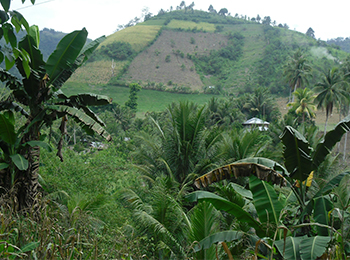About 1 result/s
-
Volume 5, Issue 1, August 2023
The Philippines is highly exposed and vulnerable to tropical cyclones (also known as typhoons), which caused over ₱352 billion worth of losses and damages to agriculture between 2000 and 2021. The study focuses on the impacts of typhoons on banana production in the Philippines. Bananas are a crucial crop for consumption, nutrition and the economy. Mindanao accounts for a majority of the country’s production. The study examines the physical sensitivity of bananas to hazards like typhoons, considering factors such as wind speed, flood-prone areas, and slope, using geographical methods.

-
Volume 4, Issue 1, April 2021
This study assessed the climate trends, changes, impacts, and adaptation strategies of farm households in five barangays in the Roxas mountain range, Koronadal City, South Cotabato by using household survey data from 265 respondents, and complimented with focus group discussions, and key informant interviews. The findings of the study revealed that climate changes are manifested by floods, landslides, and droughts as experienced by the local people which caused devastation and affected socioeconomic and environmental conditions of farming livelihood. Farmers used to have bountiful harvests, however, this situation recently changed due to the increasing climate-related risk events. The existing adaptation strategies are just stop-gap solutions that address the effects of climate change, but do not consider the root causes. To consider future changes in climate patterns, the socioeconomic and political structure and processes of the communities need to change by addressing multifaceted drivers of climate change hazards and their impacts. Some grassroot-level transformative adaptation strategies identified in the study consisted of socioeconomic facets, specifically, investment in children’s education, financial management, family planning, and development of alternative on-farm and nonfarm livelihood options. The environmental aspect, including the promotion of agroforestry system, water impoundment technologies, and advanced early warning system, were also considered.

-
Volume 4, Issue 1, November 2019
The Philippines is a global player in sugar cane production with Negros province, aka “sugarlandia”, accounting for 80% of national production. As changes in climatic conditions have and will continue to directly or indirectly affect sugarcane production, we should understand better how climate change and the El Niño-Southern Oscillation (ENSO) events will impact production targets and future irrigation requirements. This paper demonstrates how a crop model can be used to assess the present and mid-century impacts of ENSO and climate change on sugarcane growth and productivity in Negros Occidental province, Philippines.

-
Volume 3, Issue 1, February 2018
Tacloban, Philippines, the city most devastated by typhoon Haiyan in 2013, faces severe water supply constraints, particularly on the relocation sites that are expected to accommodate 40% of Tacloban's population by 2018. This study assess the impacts of climate change on the hydrological system on which Tacloban relies for water supply purposes.
-
Volume 3, Issue 1, August 2017
Philippine reefs are mega-diverse but, to date, few ecosystem models have been developed to understand their dynamics and functioning. This study assessed the status of reefs in 12 municipalities of Leyte Gulf, Philippines.
-
Volume 2, Issue 2, June 2017
General circulation models (GCMs) are essential tools for understanding climate behavior and projecting future global climate, but with limited applications for local vulnerability assessments, impact studies, and risk analyses.
-
Volume 2, Issue 1, January 2017
Advancing climate change and increasing frequency of El Niño events will impact corn growth and development in Isabela Province. This study assessed the potential impact of El Niño and climate change on yellow corn (Zea mays L.).
-
Volume 2, Issue 1, November 2016
Recently, corn farmers in Abuan Watershed and Isabela Province are experiencing declining crop yields caused by insufficient amount of rainfall. To increase crop yields and reduce production risks, research on better use of available rainfall and better understanding on effects of climate variability, and soil and field management on crop production is imperative.
-
Volume 1, Issue 1, January 2016
Recent extreme weather events have brought devastating impacts on people’s lives and infrastructure in many parts of the world. The scale of the impact of Typhoon Haiyan in the Philippines revealed a high degree of vulnerability and exposure of coastal communities to extreme events in a region that is regularly hit by tropical cyclones.